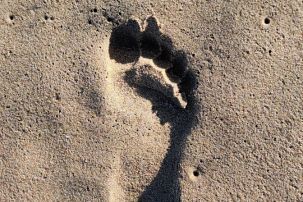Lesson summary
In this activity students learn about the concept of environmental or ecological footprints. They will learn how to measure their impact and take steps to reduce their personal footprint. Students make comparisons between the lifestyles of Aboriginal and Torres Islander peoples prior to colonisation and the current mainstream, considering the impact of consumerism on environmental footprints. They are encouraged to complete a digital footprint for homework.
Learning intentions:
Students will...
- understand their impact on the Earth
- take responsibility for their personal actions
- compare the impact on our environment between the past resource use by Aboriginal and Torres Strait Islander peoples prior to colonisation and our current resource use.
Lesson guides and printables
Lesson details
Curriculum mapping
Australian curriculum content descriptions:
Geography Year 7:
- Reflect on their learning to propose individual and collective action in response to a contemporary geographical challenge, taking account of environmental, economic and social considerations, and predict the expected outcomes of their proposal (ACHGS054)
Civics and Citizenship Year 7:
- Reflect on their role as a citizen in Australia’s democracy (ACHCS060)
Science Year 7:
- Some of Earth’s resources are renewable, but others are non-renewable (ACSSU116)
Geography Year 8:
- Reflect on their learning to propose individual and collective action in response to a contemporary geographical challenge, taking account of environmental, economic and social considerations, and predict the expected outcomes of their proposal (ACHGS062)
Science Year 8:
- Science and technology contribute to finding solutions to a range of contemporary issues; these solutions may impact on other areas of society and involve ethical considerations (ACSHE135)
Geography Year 9:
- The effects of the production and consumption of goods on places and environments throughout the world and including a country from North-East Asia (ACHGK068)
- The effects of people’s travel, recreational, cultural or leisure choices on places, and the implications for the future of these places (ACHGK069)
Geography Year 10:
- The environmental worldviews of people and their implications for environmental management (ACHGK071)
- The Aboriginal and Torres Strait Islander Peoples’ approaches to custodial responsibility and environmental management in different regions of Australia (ACHGK072)
- Reflect on and evaluate the findings of the inquiry to propose individual and collective action in response to a contemporary geographical challenge, taking account of environmental, economic and social considerations; and explain the predicted outcomes and consequences of their proposal (ACHGS080)
Cross curriculum priorities:
- OI.3 – Sustainable patterns of living rely on the interdependence of healthy social, economic and ecological systems.
- OI.6 – The sustainability of ecological, social and economic systems is achieved through informed individual and community action that values local and global equity and fairness across generations into the future.
- OI.9 – Sustainable futures result from actions designed to preserve and/or restore the quality and uniqueness of environments.
Aboriginal and Torres Strait Islander histories and cultures
- OI.2 – Aboriginal and Torres Strait Islander communities maintain a special connection to and responsibility for Country/Place throughout all of Australia.
- OI.5 – Aboriginal and Torres Strait Islander Peoples’ ways of life are uniquely expressed through ways of being, knowing, thinking and doing.
Syllabus outcomes: GE4-2, GE4-3, GE4-4, GE4-5, GE4-8, GE5-4, GE5-5, GE5-8, SC4-11PW, SC4-12ES.
Connecting lessons: All ResourceSmart AuSSI Vic audits.
Resources required
- Magazines and newspapers
- Student Worksheet
Additional info
This lesson supports schools working towards their ResourceSmart AuSSI Vic accreditation. By completing this lesson students will gain a deeper understanding of the relationship between our daily activities and the health of our environment. In this way, this lesson will help provide students with a broader context for the audits required when completing the ResourceSmart AuSSI Vic accreditation.


Welcome back!
Don't have an account yet?
Log in with:
By signing up to Cool.org you consent and agree to Cool's privacy policy to
store, manage and process your personal information. To read more, please see
our privacy policy here(Opens in new tab).
Create your free Cool.org account.
Many of our resources are free, with an option to upgrade to Cool+ for premium content.
Already have an account?
Sign up with:
By signing up to Cool.org you consent and agree to Cool's privacy policy to
store, manage and process your personal information. To read more, please see
our privacy policy here(Opens in new tab).